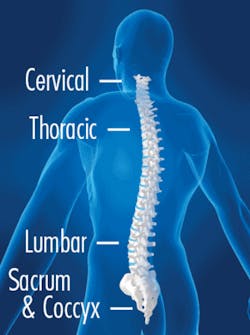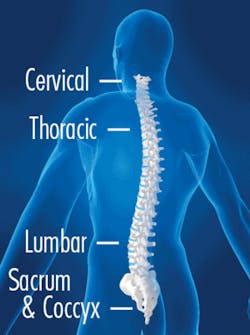Protecting Your Back, Part 1
Back pain is too common. It is not limited to construction workers and nurse’s aides; back pain affects up to 70 percent of dentists according to recent studies. While most back pain will heal in about one month with the proper combination of short-term rest and prescribed exercises, some people will develop chronic low-back pain that can interfere with everything from work, to family life, to vacation fun.
Dentists can endure low-back pain that results from the cumulative effects of seemingly nonthreatening activities such as bending forward to reach the oral cavity, bending forward and twisting to view the posterior teeth, and performing chores at home that require lifting, bending, and reaching. Here is a brief overview of back basics, risk factors for low-back pain, and general strategies to minimize these risks. Subsequent columns will address proper lifting and exercises to maintain a healthy back.
Back anatomy 101
The back is an incredible marvel that enables us to move, lift, and support our bodies in an upright position. The strength of the back comes from its ability to maintain the internal three curves formed by the 24 vertebrae. Between each vertebra is a disc that absorbs loads on the spine and enables flexibility. If discs are repetitively compressed, the jelly-like middle of the discs may bulge (or herniate) and impinge on the descending nerves. The extent to which our back supports our movements, postures, and the loads we lift (including our own bodies) depends on the health of the discs and the complex system of ligaments and muscles.
Neutral posture
Our ability to maintain a neutral posture is key to maintaining a healthy back. A neutral posture is one in which our ears, shoulders, hips, knees, and feet are aligned so that our muscles are balanced and three curves are maintained.
Check your posture by standing against a wall with your feet about 2 to 4 inches from the wall. Your upper back and buttocks should touch the wall, and your hands should fit easily in the small of the back. Because our goal is to prevent low-back pain, understanding the risk factors for low-back pain is the first step.
Risk factors for low-back pain
A risk factor is a condition that increases the chance of developing some type of condition. Just as many risk factors exist for developing dental caries (such as poor oral hygiene and poor diet), many risk factors also exist for developing low-back pain. Overall, risk factors increase the compression forces of the spine and decrease the stabilizing factors of the body. Proper use of the body, called body mechanics, can prevent the occurrence of low-back pain. Such risk factors include the following:
- Static sitting: Increases the spinal compressive forces by 30 percent.
- Sitting in a forward-bent posture: Increases spinal forces by 70 percent because the back is supporting the weight of the upper body.
- Standing and forward bending: May increase back forces by up to 100 percent or more if lifting objects.
- Lifting heavy objects: Heavy lifting with arms outstretched places additional load on the body.
- Poor physical condition: Muscles and ligaments in the back and stomach need to be flexible and strong enough to support the low back.
- Lack of rest: All muscles and joints need recovery time to heal.
General strategies to prevent low-back pain
Just as the causes of low-back pain are varied, many strategies exist to minimize the risk of low-back pain. The Occupational Safety and Health Administration presents engineering (design changes), administrative (work-routine changes), and work practice (workers’ behavior changes) controls that collectively address potential work-related problems. These strategies will be selectively addressed in upcoming issues.
- Equipment that assists with lifting: Whenever possible, use equipment such as hand trucks, carts with wheels, or any type of assistance that minimizes your need to lift and carry objects regularly.
- Use good body mechanics: Three simple rules that apply to lifting objects dramatically reduce the risk to your back - keep the back straight, keep the load close to your body, and move with your feet first. Future columns will describe these in more detail.
- Good posture: Maintain neutral posture by keeping the three curves.
- Good physical condition: Keep back, legs, and stomach muscles strong. The stronger you are, the more stresses your body can withstand.
- Move and stretch: Keep muscles balanced and symmetrical by moving out of static positions and stretching the body. For example, if you sit for long periods, be sure to stand up periodically and gently stretch the back into extension.
- Positive attitude: Smile. Be happy. It assists your helper T cells.
Martha J. Sanders, MA, MSOSH, OTR/L
Sanders is an assistant professor of occupational therapy at Quinnipiac University in Hamden, Conn. She has worked with dental practitioners for more than 15 years in rehabilitation and prevention of musculoskeletal disorders. Sanders is the editor of a textbook on ergonomics, “Ergonomics and the Management of Musculoskeletal Disorders.” E-mail her at [email protected].


